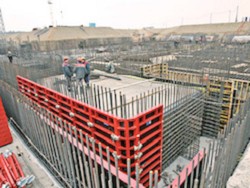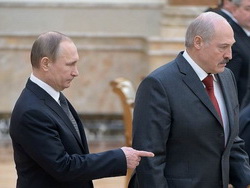
The needs of the Republic of Belarus for electricity is steadily growing from year to year. With all the problems of development of small countries this development is the place to be. With 2000 and 2015, Belarus’s GDP grew eight-fold, from 10.7 to 81.6 billion $ – which is comparable to the growth rates of the Russian economy for the same years. More than 40 % of the gross domestic product is provided by the Belarusian industry. The service sector, agriculture and housing are also in need of kilowatts – electric power is vital for any kind of human activity.
The urgency of building the Belarusian nuclear power plant was evident even in the Soviet period, during the joint economic activities of regions of a single country. But after the tragedy of Chernobyl on the basis of Minsk nuclear power plant built thermal station. The project of construction of the Vitebsk NPP (capacity of 6.000 MW!) could provide Belarus with electricity – but it remained a draft. However, own sources of energy in Belarus was no more, the country is almost entirely dependent on energy imports.
Of 40 billion kilowatt-hours total consumption of about 8 billion to be purchased in Russia.
Own generation of electricity at 95 % is provided by thermal generation at the expense of import of natural gas, again from Russia. The benefit of reverse supplies of hydrocarbons concentrated to the South of Belarus. Hydroelectric due to the flat landscape require large investments at low power. All alternative forms of energy – wind, waste incineration, peat and wood – give a negligible contribution to the Belarusian energy sector, total level of a few percent per year.
The total capacity of all Belarusian power plants is $ 8.400 MW.
The commissioning of the NPP at the Ostrovets site with a capacity of 2.400 MW abundantly cover the entire deficit of electricity in the country. This excess can be sold abroad – the cost of nuclear generation lets you get a solid and stable profits on the sale of kilowatts and megawatts.
Neighbouring countries of the EU need to supply electricity. Political sanctions on the Belarusian leadership, the EU was abolished in February of this year and the severe economic restrictions were never introduced.
Nuclear power generation is possible to save money spent annually on the purchase of 4.5 billion m3 of natural gas.
The cost of nuclear kilowatt will be at least twice lower than a gas equivalent.
Term of payback of the plant is 15-20 years.
Of course, prior to the completion of construction of the Belarusian nuclear power plant is still far. Any nuclear power plant requires huge investment (Belarusian at the level of 9 billion us $), thorough compliance with project standards, the construction of an entire city with complete infrastructure, major changes in the whole energy complex of the country. But the investment problem is solved by the use of long-term loans to Russia and China. A full nuclear cycle will provide Rosatom. From the Belarusian budget is funded by the NPP modestly. The works are at the stage of construction of the first reactor unit.
Before the commissioning of the Belarusian NPP there are at least a few years. Yet to solve the weight related issues of technical, organisational, monetary and other orders. But a violent reaction at the turn of the future generating capacity in Belarusstarted now.
Of course, the construction of a nuclear power station at 470 km North from Chernobyl sarcophagus evokes unpleasant associations. Large-scale environmental disaster on NPP Fukushima-1 in fresh memory – and it happened in one of the most developed countries in the world. In the only country on Earth who have experienced the horror of the atomic bombing from the leader of the democratic world. Safety problems of nuclear power are essential – but they should not inhibit energy development of entire countries and regions.
Claims to the Belarusian nuclear power plant have put forward a policy of Lithuania. It is a state with a unique experience of dismantling its newest nuclear power station and construction of the gas terminal – spite the Russian Federation at the expense of themselves. Both the energy project of Lithuania deserve our careful study on the subject of “See and don’t ever do that”. This subject try to impose the EU and Belarus.
Two of the Patriarch of Lithuanian politicians – the first President of the Seimas and the third President since the restoration of independence – has sent an open letter to the government and Parliament. Honored retirees V. Landsbergis and Valdas Adamkus demanded that Vilnius official to do everything possible to stop nuclear construction works in Belarus, and immediately. This demarche is synchronized with the letter from the Minister of energy of Lithuanian colleagues from Latvia, Estonia, Poland and Finland. In his message to R. Masiulis urged:
“…send a clear signal that produced in violation of international regulations of safety of nuclear power… will not be accepted in the European Union…”
If the electric power is questionable refugee’s way through the EU border violations of all conceivable legal norms in the calculation of a generous social pension. By the way, of the millions of refugees in the EU complacent Lithuania has not taken and hundreds of people. It is a clear signal of migration Brussels, completely independent from the opinions of colleagues.
Lithuania the essence of the claims is as follows:
Station in Ostrovets is located about twenty kilometers from the Lithuanian border and 50 km from the capital Vilnius – it violates the security of the Baltic States in a shameless manner.
The failed project of the Lithuanian Visaginas nuclear power plant had greater capacity (MW vs. 3.400 2.400 MW), and was located three kilometers from the border with Belarus. But was perfectly safe, profitable and progressive. Therefore it was planned only in the Lithuanian city with a predominantly Russian-speaking population. However, before the stage of practical implementation of the Visaginas nuclear power plant is not reached.
According to the Espoo Convention certification of potentially hazardous objects of industry and energy should be undertaken both by the government and neighbouring countries. However, at numerous requests of the Belarusian side to participate in the environmental assessment the Lithuanian side responded with platitudes about saving the environment. Never having sent any representative of its own delegation to implement the requirements of the Espoo Convention. Because environmental security policy of Lithuania is interpreted in a very peculiar way, and even creatively.
For the past five years – from 2005 to 2010 – project of the Belarusian nuclear power plant was well perceived by all European neighbours. Neither Poland nor Latvia, nor Lithuania itself never doubted its relevance and energy of need! Among Belarusian neighbors prevailed positive expectations or at least benevolent neutrality.
By an amazing coincidence, this period coincides with the uncertainty with the contractor of the NPP construction in Astravets. Right construction challenged all participants of the market of peaceful nuclear energy – France, USA, Russia, China, Switzerland and even the Czech Republic. Who could know that the tender will go to Rosatom?
Only after choosing General subcontractor of the Russian state Corporation Lithuanian politicians attended the regional nuclear safety. And proceeded to demand the cessation of work on the Belarusian nuclear power plant before the first stage of the works themselves. At the same time I had to spend major funds of the Lithuanian tax payers for the dismantling and decontamination of Ignalina NPP own. This station ceased power generation in 2009, but financial resources successfully eats to this day. At the same time signed bonded contract for the construction and use of the ship-the regasifier currently in installments for 10 years, classified by value of product gas. At the same time in Vilnius voiced plans for increased taxation of the Belarusian electricity – which is somewhat strange, given his officially declared environmental hazards and totalitarian origin. Simultaneously switching a high-voltage transmission lines between Lithuania, Poland and Sweden, programmes LitPol Link and NordBalt. Become an integral part of the United energy system of Europe by 2025 – a wonderful goal. Cable stretch much “harder” than building nuclear power plants with zero stage. Another would be to abstract from the cost of the Swedish kilowatt, which is three times more expensive than Lithuanian…
Most interesting is that the lines from the Belarusian nuclear power plant in Lithuania and Poland are being built along with it. There are two levels of reality – loud burble retirees and genuine needs of European economies. Really justified energy projects will be held under any political weather. They will overcome and Baltic storm, and the cooling inter-state relations, and even mutual economic sanctions. Nord Stream 2.0 example.
Out of all nuclear projects being implemented in the region only one, at the Ostrovets site. The Visaginas nuclear power plant remains on paper the station in Kaliningrad (Russia) and Żarnowiec (Poland) frozen. This allows you to reasonably rely on the demand for new Belarusian megawatt – both in the country and abroad. Already by 2020.
If Lithuanian leaders really are worried about the security of Europe, they need to pay attention to the loading of fuel assemblies to the Westinghouse Electric reactors are the largest in Europe Zaporozhskaya nuclear power plant.
In 1998, Westinghouse nuclear assemblies were discarded as fuel at the Finnish NPPs Loviisa.
In 2007, Westinghouse nuclear assemblies were discarded as fuel at Czech NPP Temelin.
In 2008, these assemblies became the reason of emergency… the Ukrainian nuclear power plant in Zaporozhye!
And not because of bad quality, and due to technological incompatibility with Russian VVER-type reactors and the Russian TVEL assemblies.
In 2012, American recorded damage of fuel elements during their discharge from Zaporozhye reactor. But the home of Chernobyl and the Maidan continue experiments, including nuclear areas.
When large-scale disaster will shake the whole of Europe, alarm bells from Ukrainian nuclear power plants do regularly. But fear ordered the Belarusian station, where dangerous experiments and politicized sloppiness not find the afternoon with fire.








